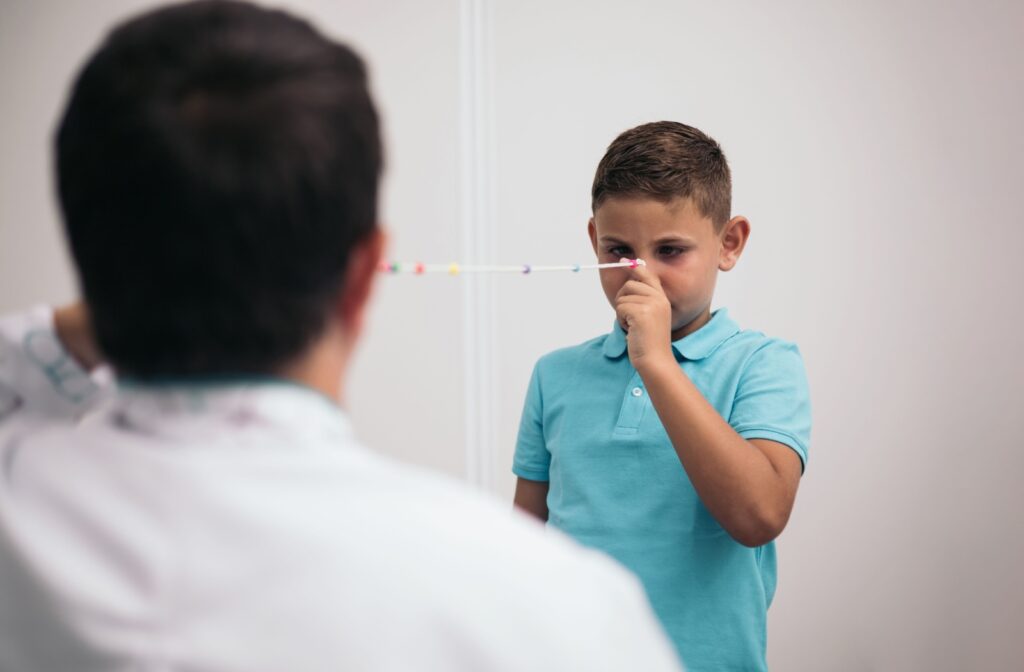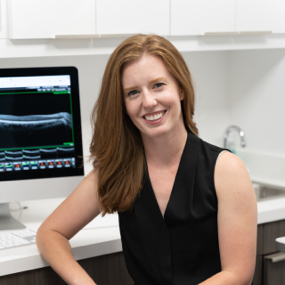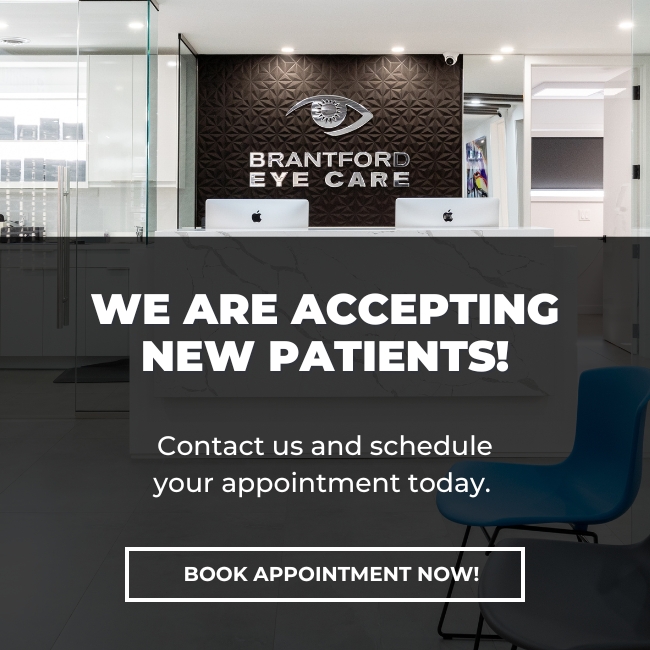Having 2 eyes gives us a full, comprehensive view of our surroundings. When one eye doesn’t work as well as it could, it forces the other eye to work twice as hard, leading to gaps in the overall picture.
Strabismus, also known as “a lazy eye”, occurs when the eyes are misaligned and have difficulty working together. Without timely intervention, it can impair other areas of your vision, affecting your ability to complete daily activities.
Fortunately, strabismus can be improved and corrected.
Vision therapy is an effective, noninvasive program that uses tools, exercises, and activities to encourage the eyes and brain to work together harmoniously by practicing, learning, and strengthening visual skills.
Vision therapy can help you or your child achieve and maintain essential visual skills.
Your Guide to Vision Therapy
Vision therapy improves visual skills by strengthening the connection between the brain and eyes, channeling the brain’s ability to form new neural pathways. Through tailored exercises, tools, and activities, vision therapy teaches the eyes how to work together more efficiently.
Vision therapy is an effective, noninvasive approach to treating a range of eye conditions, including:
- Strabismus (lazy eye)
- Amblyopia
- Convergence insufficiency
- Double vision
- Eye strain
Vision therapy is based on the principle that vision is a set of skills that can be learned, like riding a bike or playing an instrument, rather than being innate. There’s more to vision than just seeing. It’s also about processing and responding to what you are seeing.
Therefore, you can train your eyes and brain to work together more efficiently. Through this process, you can overcome visual challenges by learning, targeting, and practicing specific skills to improve vision.
Through a customized therapy plan for each patient, we can strengthen and realign eye muscles to improve:
- Accommodation
- Binocularity
- Coordination
- Depth perception
- Eye tracking
- Focus adjustment
Although children make up a large portion of our program (and usually respond quickly to therapy because their brains and eyes are still developing), people of all ages can benefit from vision therapy, especially since conditions like strabismus can appear in children and adults.
Strabismus: What You Need to Know
Strabismus, more colloquially known as “lazy eye”, is a condition where the eyes do not align properly. The misalignment develops when the muscles controlling eye movement don’t work in harmony, leading to one eye turning in a different direction.
Leaving strabismus untreated can lead to impaired vision or amblyopia , as the brain might begin to ignore visual signals from the misaligned eye.
When the brain ignores signals, it can impair other vital areas of your vision, such as depth perception and binocular vision (the ability of the eyes to coordinate), making everyday activities more challenging.
Starting treatment sooner can help support positive outcomes long-term. The pathway to improved vision always begins with routine eye exams.
Through annual children’s exams, your optometrist can detect symptoms of strabismus, which generally include:
- Double vision
- Headaches
- Eye Strain
- Frequently squinting or closing one eye
- Crossed or misaligned eyes that turn inward, outward, upward, or downward
Early intervention can improve visual skills and support overall development. Strong, healthy vision is foundational for kids’ learning, development, and socializing. Together, we can work toward a successful and healthy visual future.

Finding Alignment with Vision Therapy
Vision therapy is an effective way to improve and treat strabismus. We can promote proper eye alignment by strengthening the eye muscles and training the brain to process visual input more effectively.
Every case of strabismus is unique, so we tailor each patient’s treatment plan to address their specific concerns. As the sessions progress, we continuously adjust the exercises, tools, and activities to match the progression and challenges of each patient.
A treatment plan might generally include:
- Exercises, including tracking moving objects, practicing focus shifts, or performing stereoscopic activities, to help develop depth perception
- Tools, such as prism glasses, gradually adjust the angles at which the eyes view images, encouraging the eyes to work together
- Progressive technologies, such as computer-assisted visual exercises, simulating real-world scenarios, dynamically challenging the visual system to reinforce proper eye coordination
- Patching therapy to help strengthen the weaker eye so both eyes can eventually balance the workload
Learning any skill requires dedication and effort. Finding success in vision therapy depends on several factors, including:
- Age
- Severity of strabismus
- Commitment to the program
- Overall health
Your unique program may vary, but our vision therapy program typically lasts about 35 weeks, with weekly 55-minute sessions focused on achieving and maintaining significant improvements. For severe cases, we may combine vision therapy with other treatments, such as corrective lenses, prism glasses, or surgery, to enhance outcomes.
Our goal through vision therapy is to help you achieve improved vision and maintain it by applying the visual skills you’ve learned—not an indefinite program. In other words, we’re here to see you graduate!
Strengthen Your Vision
Vision therapy offers a unique approach to correcting and improving certain eye conditions, like strabismus. Although not everyone requires a helping hand, those who do can significantly benefit from the visual skills we learn and practice together.
At Brantford Eye Care, we’re committed to delivering a personalized, informed, and proactive experience for every one of our patients. Connect with our team to schedule a consultation and learn how vision therapy can enhance your visual skills.




